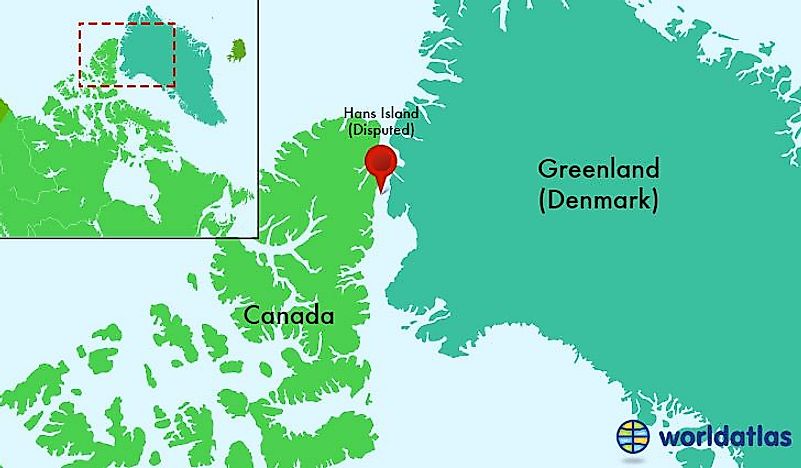Hans Island – Property of Canada or Denmark?

Whereas many people are familiar with famous territorial disputes, be it Taiwan, Kosovo, or Crimea, there exists one battle which has eluded widespread awareness.
Both Canada and Denmark are known for their peaceful and democratic nature; one does not think of them as nations prone to saber-rattling. Despite this, Canada and Denmark have shared a territorial dispute for almost a century. At the center of this dispute is a small outcropping known as Hans Island.
The dispute over Hans Island is genuine, having soured Danish-Canadian relations for decades and remains unresolved to this day. This war of words (and whiskey – more on that later) over control of a tiny portion of the vast High Arctic, remains a key point in bilateral relations.
Uncertain Past
With Danish control over Greenland established in 1815, Denmark has long had a significant presence in the High Arctic region. Following the purchase of Alaska by the United States, and the formation of Canada in 1867, British and American interest in the area increased. Anglo-American efforts to explore and chart the region often relied on Inuit and Danish peoples in Greenland.
Canadian sovereignty in the High Arctic came abruptly in 1880, when Britain transferred the British Arctic Territory (based on the claims of 16th century explorer Martin Frobisher) to Canada. The point of this was to prevent American claims based on the Monroe Doctrine (no European ownership in North America) to the region. Given imperfect mapping techniques and the difficulties inherent in Arctic exploration, Hans Island was not explicitly included in this transfer.
In the 1920s, Danish explorers were finally able to accurately map Hans Island. The island is a mere 1.3 sq km, uninhabited, devoid of trees and with barely any soil. It is so remote that the closest inhabited location is Alert, Nunavut, Canada, 198 km to the north. Indeed, very little distinguishes Hans Island from the thousands of other barren islands in the area. Consequently, one rightly wonders what all the commotion is about.
The reason is that this piece of land is located in the middle of the 35 km wide Nares Strait, which separates Nunavut from Greenland. Under international law, states have control over territorial waters which extend 12 miles (22.2km) from shore. Consequently, Hans Island falls within both the Danish and Canadian 12-mile zone, with both claiming the island as a result.
Dispute Escalates in 20th Century
In the wake of the Danish mapping of the island, as well as pressure from Copenhagen; the status of Hans Island was brought to the Permanent Court of International Justice (PCIJ), which ruled in favour of Denmark in 1933. However, given the remoteness of the island and the disintegration of the League of Nations (of which the PCIJ was the judicial organ) in the 1930s, this ruling did not resolve matters. Furthermore, following WWII both the League of Nations and PCIJ were abolished and superseded by the UN and International Court of Justice respectively. Consequently, the now eighty-year-old ruling of a defunct court has little power.
Following the 1930s, Hans Island faded into obscurity for several decades as both Canada and Denmark attended to more pressing concerns. Later, the island once again fell through the cracks of international law in the early 1970s. In 1972-1973, Canada and Denmark agreed on the demarcation of maritime borders in the Arctic. Both countries recognized each others' claims extending out from the continental shelf, making the agreement the largest of its kind in history. Despite the scope of the negotiations, the status Hans Island remains unresolved. The maritime border immediately north and south of the island were established, but not the island itself.
New Millennium, Same Dispute
Despite languishing for several decades after 1973, the issue of Hans Island returned to international headlines with a vengeance in 2004. In that year, the official opposition in the Canadian parliament cited Hans Island as a reason for increasing defense spending. This suggestion prompted a swift reaction from Denmark, which summoned the Canadian envoy to the Danish Minister of Foreign Affairs, to explain Ottawa's statements.
Relations were further strained when, on July 13th 2005, Canadian forces landed on the island, erecting an Inukshuk and Canadian flag. The following week, Canadian Defence Minister Bill Graham landed on the island. This led Denmark to file a complaint stating that “we consider Hans Island to be part of Danish territory, and will therefore hand over a complaint about the Canadian minister's unannounced visit.”
Fortunately, despite the strong rhetoric, both sides maintain a sense of humor on the issue. As successive Danish and Canadian landings on the island erect and dismantle flag poles and markers, they leave presents for the next contingent. This 'whiskey war' was initiated in 1984, when the Danish minister for Greenland landed on the island leaving a bottle of schnapps and a sign proclaiming “Welcome to the Danish Island.”
Peter Takso Jensen, head of international law department of the Danish Foreign Ministry, noted that “when Danish military go there, they leave a bottle of schnapps. And when Canadian military forces come there, they leave a bottle of Canadian Club and a sign saying 'Welcome to Canada'”











